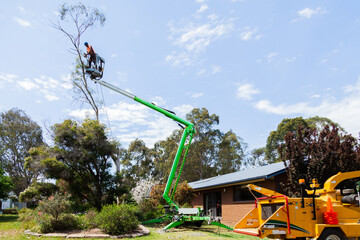Trees are essential to the beauty and health of any landscape, providing shade, improving air quality, and enhancing property value. Proper tree care is not just about aesthetics—it’s also about safety, sustainability, and long-term growth. Whether you have a few ornamental trees or a large collection of mature trees, understanding effective tree care practices ensures that your landscape remains vibrant and healthy for years to come.

The Importance of Regular Tree Maintenance
Regular tree maintenance is vital for both safety and aesthetics. Overgrown or weak trees can pose risks, such as falling branches or damage to property during storms. Routine care, including pruning, trimming, and inspections, helps prevent hazards while encouraging healthy growth.
Proper maintenance also enhances the visual appeal of your property. Well-maintained trees add structure and beauty to gardens, driveways, and public spaces. They can serve as focal points, frame outdoor areas, and create natural privacy screens.
Pruning and Trimming for Healthy Trees
Pruning and trimming are essential tree care practices that promote growth and longevity. Removing dead or diseased branches prevents the spread of infections and pests. Additionally, trimming branches that interfere with structures, power lines, or walkways reduces safety risks.
Pruning is also important for maintaining the tree’s shape and encouraging strong branch development. Proper pruning techniques include cutting at the branch collar, avoiding large cuts that may damage the tree, and removing no more than 25% of the canopy in a single session. Regular trimming helps trees grow evenly and enhances their overall health.
Watering and Mulching Strategies
Adequate watering is crucial for tree health, especially for young or newly planted trees. Deep, infrequent watering encourages roots to grow downward, establishing a strong foundation. Avoid shallow watering, as it promotes surface roots that are vulnerable to drought and wind damage.
Mulching is another key practice that supports healthy trees. A layer of organic mulch around the base of the tree helps retain soil moisture, regulate temperature, and suppress weeds. Ensure that mulch is spread evenly and kept away from direct contact with the trunk to prevent rot and pest infestations.
Fertilization and Soil Health
Fertilizing trees provides essential nutrients that may be lacking in the soil. A soil test can determine nutrient deficiencies and guide the selection of the appropriate fertilizer. Nitrogen, phosphorus, and potassium are critical for promoting growth, root development, and leaf production.
Healthy soil also plays a crucial role in tree vitality. Aeration and proper drainage prevent root suffocation and allow oxygen to reach the root system. Maintaining soil health ensures that trees receive the nutrients and moisture they need to thrive.
Pest and Disease Management
Trees are susceptible to a variety of pests and diseases that can impact their health and longevity. Common issues include fungal infections, insect infestations, and bacterial diseases. Early detection and treatment are essential to prevent widespread damage.
Integrated pest management strategies, including monitoring, biological controls, and selective treatments, can help maintain tree health. Removing infected branches, applying appropriate treatments, and encouraging natural predators are effective ways to manage pests without harming the environment.
Tree Protection During Construction and Landscaping
Trees are sensitive to changes in their environment, and construction or landscaping projects can cause significant stress. Protecting trees during such activities involves minimizing root disturbance, avoiding soil compaction, and providing physical barriers around the tree’s drip line.
Preserving existing trees during construction not only enhances the property’s aesthetic value but also reduces long-term costs associated with replacement and recovery. Proper planning ensures that trees continue to flourish even amidst development projects.
Seasonal Tree Care Practices
Seasonal changes affect tree growth and maintenance needs. Spring is an ideal time for planting and fertilizing, while summer requires consistent watering and pest monitoring. Fall is a good period for pruning and preparing trees for winter dormancy. Winter care includes inspecting for damage, removing snow from branches, and monitoring for signs of disease that may become apparent in early spring.
Adapting tree care practices to seasonal conditions ensures that trees remain healthy year-round and are better equipped to withstand environmental stressors.
Benefits of Professional Tree Care Services
While basic tree care can be performed by homeowners, professional tree care services provide expertise and equipment for more complex tasks. Certified arborists and tree care specialists offer advanced pruning, tree removal, disease management, and emergency services.
Hiring professionals ensures that trees are handled safely and maintained according to industry standards. Professional care reduces the risk of injury, property damage, and long-term tree health problems, providing peace of mind for property owners.
Sustainable Tree Care Practices
Sustainability is increasingly important in modern landscaping. Environmentally responsible tree care involves using organic fertilizers, avoiding harmful chemicals, and promoting native tree species. Planting diverse species reduces susceptibility to pests and disease, while preserving mature trees supports local wildlife and ecosystem balance.
Sustainable practices not only protect the environment but also ensure that trees continue to provide shade, beauty, and ecological benefits for future generations.
Enhancing Property Value with Proper Tree Care
Well-maintained trees significantly enhance property value by creating an attractive and functional landscape. Healthy, mature trees can increase curb appeal, improve energy efficiency by providing shade, and create a welcoming outdoor environment. Buyers and visitors alike appreciate the beauty and benefits of properly cared-for trees.
Investing in tree care is a long-term strategy that preserves the value of your property while contributing to a healthier and more enjoyable environment.
Tree care is an essential aspect of property maintenance, combining aesthetics, safety, and environmental responsibility. Pruning, watering, mulching, fertilization, pest management, and seasonal maintenance all play critical roles in promoting healthy growth and longevity.
Whether performed by homeowners or professional arborists, proper tree care ensures that landscapes remain vibrant, sustainable, and valuable. By adopting consistent care practices, property owners can enjoy the beauty, shade, and ecological benefits that trees provide for years to come.